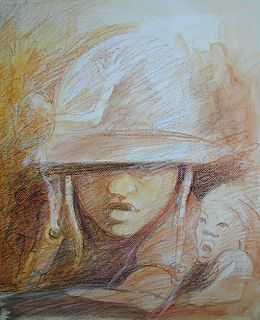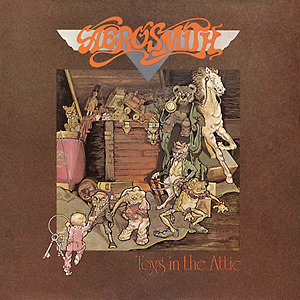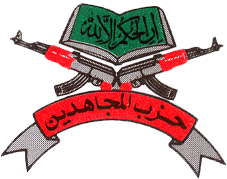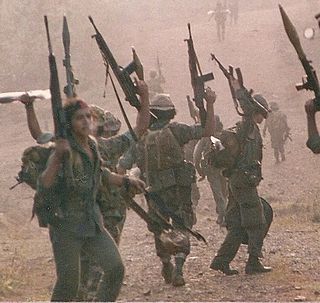Related Research Articles

A civil war, also known as an intrastate war in polemology, is a war between organized groups within the same state . The aim of one side may be to take control of the country or a region, to achieve independence for a region, or to change government policies. The term is a calque of Latin bellum civile which was used to refer to the various civil wars of the Roman Republic in the 1st century BC.
Nationality is a legal identification of a person in international law, establishing the person as a subject, a national, of a sovereign state. It affords the state jurisdiction over the person and affords the person the protection of the state against other states.

Children have been recruited for participation in military operations and campaigns throughout history and in many cultures. Child soldiers within state armed forces, non-state armed groups, and other military organizations may be trained and used for combat, assigned to support roles such as porters or messengers, or used for tactical advantage as human shields or for political advantage in propaganda. For example, thousands of children participated on all sides of the First World War and the Second World War.

Since the Partition of British India in 1947 and subsequent creation of the dominions of India and Pakistan, the two countries have been involved in a number of wars, conflicts, and military standoffs. A long-running dispute over Kashmir and cross-border terrorism have been the predominant cause of conflict between the two states, with the exception of the Indo-Pakistani War of 1971, which occurred as a direct result of hostilities stemming from the Bangladesh Liberation War in erstwhile East Pakistan.

Toys in the Attic is the third studio album by American rock band Aerosmith, released in April 1975 by Columbia Records. Its first single, "Sweet Emotion", was released on May 19 and the original version of "Walk This Way" followed on August 28 in the same year. The album is the band's most commercially successful studio LP in the United States, with nine million copies sold, according to the RIAA. In 2003, the album was ranked No. 228 on Rolling Stone's list of The 500 Greatest Albums of All Time. The album's title track and their collaboration with Run-DMC on a cover version of "Walk This Way" are included on the Rock and Roll Hall of Fame list of the "500 Songs that Shaped Rock and Roll".

The Indo-Pakistani War of 1947–1948 or the First Kashmir War was an armed conflict that was fought between India and Pakistan over the princely state of Jammu and Kashmir from 1947 to 1948. It was the first of four Indo-Pakistani wars that was fought between the two newly-independent nations. Pakistan precipitated the war a few weeks after its independence by launching tribal lashkar (militias) from Waziristan, in an effort to capture Kashmir and to preempt the possibility of its ruler joining India. The inconclusive result of the war still affects the geopolitics of both countries.

Camilla is one of the largest asteroids from the outermost edge of the asteroid belt, approximately 250 kilometers in diameter. It is a member of the Sylvia family and located within the Cybele group. It was discovered on 17 November 1868, by English astronomer Norman Pogson at Madras Observatory, India, and named after Camilla, Queen of the Volsci in Roman mythology. The X-type asteroid is a rare trinary asteroid with two minor-planet moons discovered in 2001 and 2016, respectively. It is elongated in shape and has a short rotation period of 4.8 hours.

Hizb-ul-Mujahideen is an Islamist militant group operating in Indian-administered Kashmir. Its goal is to separate Kashmir from India and merge it with Pakistan. The group has claimed responsibility for multiple attacks in India.

The insurgency in Jammu and Kashmir is against the Indian administration of Jammu and Kashmir, a region constituting the southern portion of the larger Kashmir region, which has been the subject of a dispute between India and Pakistan since 1947.

In international relations, violent non-state actors (VNSA), also known as non-state armed actors or non-state armed groups (NSAGs), are individuals and groups that are wholly or partly independent of governments and which threaten or use violence to achieve their goals.
Secession in India typically refers to state secession, which is the withdrawal of one or more states from the Republic of India. Whereas, some have wanted a separate state, union territory or an autonomous administrative division within India. Many separatist movements exist with thousands of members, however, some have low local support and high voter participation in democratic elections.
Human rights abuses in Jammu and Kashmir range from mass killings, enforced disappearances, torture, rape and sexual abuse to political repression and suppression of freedom of speech. The Indian Army, Central Reserve Police Force (CRPF), Border Security Personnel (BSF) have been accused and held accountable for committing severe human rights abuses against Kashmiri civilians. Militant groups have also been held responsible for similar crimes, but the vast majority of abuses have been perpetrated by the armed forces of the Indian government.

Child Soldiers in Africa refers to the military use of children under the age of 18 by national armed forces or other armed groups in Africa. Typically, this classification includes children serving in non-combatant roles, as well as those serving in combatant roles. In 2008, it was estimated that 40 percent of child soldiers worldwide were in Africa, and that the use of child soldiers in armed conflict was increasing faster than any other continent. Additionally, average age of children recruited as soldiers appears to be decreasing. As of 2017, the UN listed that seven out of fourteen countries recruiting and using child soldiers in state forces or armed groups were in Africa: Central African Republic, Democratic Republic of the Congo, Mali, Nigeria, Somalia, South Sudan, Sudan.

The Exodus of Kashmiri Hindus, also known as the Exodus of Kashmiri Pandits, refers to the emigration of Hindus out of the Kashmir Valley.
The Kashmir Conflict has been characterized by large scale usage of sexual violence by multiple belligerents since its inception.
Bleed India with a Thousand Cuts is a military doctrine followed by the Pakistani military against India. It consists of waging covert war against India using insurgents at multiple locations. According to scholar Aparna Pande, this view was put forward in various studies by the Pakistani military, particularly in its Staff College, Quetta. Peter Chalk and Christine Fair cite the former director of the Inter-Services Intelligence (ISI) explicating the strategy.
The Pakistan Armed Forces have been criticized for eroding democratic processes in Pakistan, for being the largest business conglomeration in the country and for excessive control over the domestic and foreign policies of Pakistan. Critics of the Pakistan Army, such as human rights activist Manzoor Pashteen, have been jailed while like-minded Pakistani citizens are warned against criticizing the military establishment. In Pakistan, the military is considered a part of what is known as The Establishment; they control the state through a backdoor and are a part of a working deep state.

Mubarak Olalekan Bakare is a Nigerian art ambassador, model, actor, and at 6ft 9, one of the tallest men in Nigeria. Born on November 14, 1995, Olalekan was the 2016 winner of the Mr. Kwara International beauty pageant.
References
- ↑ Singer, Peter Warren (7 April 2006). Children at War. University of California Press. p. 27. ISBN 978-0520248762.
- ↑ Marg, Rohini; Purano Baneswar (16 December 2009). Child Soldiers: Crime against Humanity (PDF). Conflict Study Center. p. 13.[ permanent dead link ]
- ↑ Whitman, Shelly (19 June 2012). W Andy Knight; Frazer Egerton (eds.). The Routledge Handbook of the Responsibility to Protect. Routledge. pp. 152–153. ISBN 978-0415600750.
- ↑ Rosen, David M. (23 April 2012). Child Soldiers. ABC-CLIO. p. 6. ISBN 978-1598845266.
- ↑ Resource Centre, Asian Legal (7 September 2007). "India: Child soldiers being used as expendable pawns in armed conflicts". Asian Human Rights Commission.
- ↑ Hartjen, Clayton; S. Priyadarsini (2011). The Global Victimization of Children: Problems and Solutions (2012 ed.). Springer. p. 106. ISBN 978-1461421788.
- ↑ Child Soldiers Global Report 2008 (PDF). Child Soldiers International aka Coalition to Stop the Use of Child Soldiers. 2008. p. 12.
- ↑ Doek, Jaap E. (2008). Child Soldiers Global Report 2008. Coalition to Stop the Use of Child Soldiers. p. 170.
- ↑ McCracken, Kevin; David R. Phillips (14 June 2012). Global Health: An Introduction to Current and Future Trends (1st ed.). Routledge. p. 244. ISBN 978-0415557573.